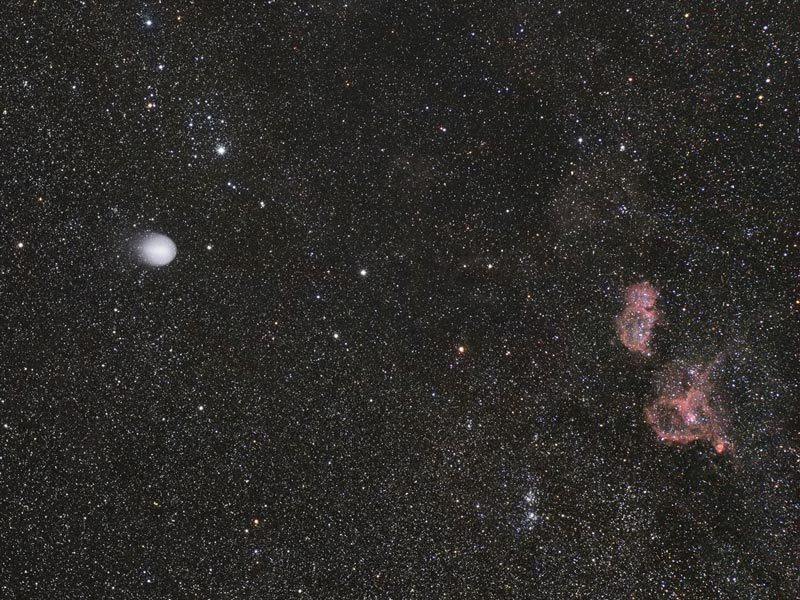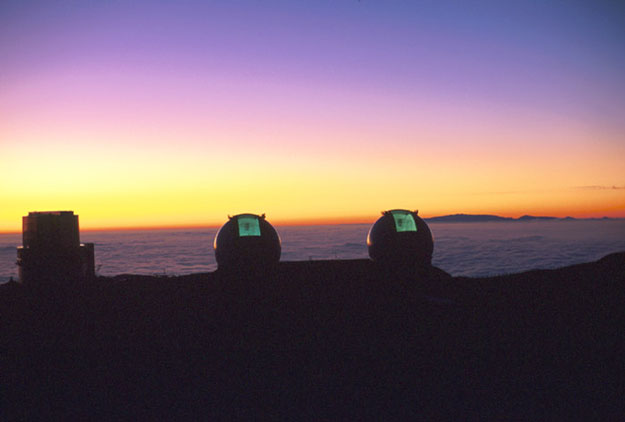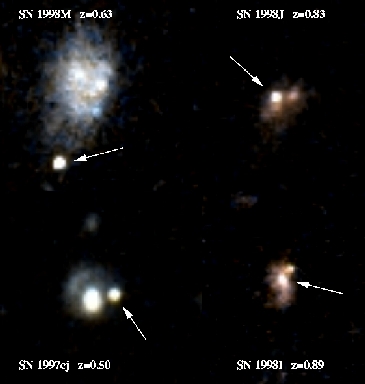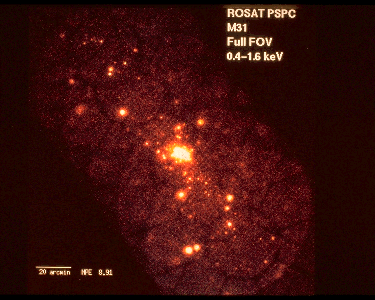| << Previous | Index | Next >> |
2014 Comet Lovejoy has become visible to the unaided eye. To see the comet, just go outside an hour or so after sunset and look for a fuzzy patch to the right of Orion's belt. Binoculars and a star chart may help. Pictured here, Comet C/2014 Q2 (Lovejoy) was captured three days ago passing nearly in front of M79, the globular star cluster visible as the bright spot slightly above and to the left of the comet's green-hued coma. The nucleus of Comet Lovejoy is a giant dirty iceberg that is shedding gas into a long and intricate ion tail, extending across the image, as it nears the Sun. The comet is expected to become even easier to spot for northern observers during January, as it is rises earlier and, hopefully, continues to brighten.
2013 The Horsehead Nebula is one of the most famous nebulae on the sky. It is visible as the dark indentation to the red emission nebula in the center of the above photograph. The horse-head feature is dark because it is really an opaque dust cloud that lies in front of the bright red emission nebula. Like clouds in Earth's atmosphere, this cosmic cloud has assumed a recognizable shape by chance. After many thousands of years, the internal motions of the cloud will alter its appearance. The emission nebula's red color is caused by electrons recombining with protons to form hydrogen atoms. Also visible at the bottom left of the picture is a greenish reflection nebulae that preferentially reflects the blue light from nearby stars.
2012 What do Saturn's rings look like from the dark side? From Earth, we usually see Saturn's rings from the same side of the ring plane that the Sun illuminates them -- one might call this the bright side. Geometrically, in the above picture taken in August by the robot Cassini spacecraft now orbiting Saturn, the Sun is behind the camera but on the other side of the ring plane. Such a vantage point gives a breathtaking views of the most splendid ring system in the Solar System. Strangely, the rings have similarities to a photographic negative of a front view. For example, the dark band in the middle is actually the normally bright B-ring. The ring brightness as recorded from different angles indicates ring thickness and particle density of ring particles. At the top left of the frame is Saturn's moon Tethys, which although harder to find, contains much more mass than the entire ring system.
2011
2010 Looking back on the year, have you wondered where the Sun was in the sky each day during 2010 at exacty 9am UT? Of course you have. Search no further for the answer! It was somewhere along this celestial figure 8 curve known as an analemma. Recorded from a residential backyard in the small town of Veszprem, Hungary, this composite analemma image consists of 36 separate exposures of the Sun made at 9:00 UT, spaced throughout the year, plus a background image made without a solar filter. The background image was taken on the sunny afternoon of October 9 (13:45 UT). On the left is the photographer's shadow. The positions of the Sun at the 2010 solstice dates are at the upper (June 21) and lower (December 21) extremes of the analemma curve. On the equinox dates (March 20, September 23) the Sun was along the curve half way between the solstices. The tilt of planet Earth's axis and the variation in speed as it moves around its elliptical orbit combine to produce the graceful analemma curve.
2009 Dust makes this cosmic eye look red. The eerie Spitzer Space Telescope image shows infrared radiation from the well-studied Helix Nebula (NGC 7293) a mere 700 light-years away in the constellation Aquarius. The two light-year diameter shroud of dust and gas around a central white dwarf has long been considered an excellent example of a planetary nebula, representing the final stages in the evolution of a sun-like star. But the Spitzer data show the nebula's central star itself is immersed in a surprisingly bright infrared glow. Models suggest the glow is produced by a dust debris disk. Even though the nebular material was ejected from the star many thousands of years ago, the close-in dust could be generated by collisions in a reservoir of objects analogous to our own solar system's Kuiper Belt or cometary Oort cloud. Formed in the distant planetary system, the comet-like bodies would have otherwise survived even the dramatic late stages of the star's evolution.
2008
Credit & Copyright: Video: Till Credner, (The Sky in Motion.com). Music: túrána hott kurdis by hasta la otra méxico!
2007 Two spectacular comets graced Earth's skies during 2007. Both comets became bright enough to be seen by the unaided eye of the casual sky enthusiast. Early in 2007, Comet McNaught grew brighter than any comet in 40 years, displaying a beautiful dust tail that flowed across the sky. Comet McNaught (c/2006 P1) became known as the Great Comet of 2007, sported unusual striations in its expansive dust tail, and showed unexpectedly complex chemistry in its ion tail. Toward the year's end, normally docile and faint Comet Holmes brightened suddenly and unexpectedly to naked eye visibility. Remarkably, Comet 17P/Holmes stayed bright for weeks even though it lies beyond the orbit of Mars. No distant comet in recent history has remained so bright for so long. In this view, a white Comet Holmes was photographed in early December posing with the Heart and Soul Nebulas.
2006 The past year was extraordinary for the discovery of extraterrestrial fountains and flows -- some offering new potential in the search for liquid water and the origin of life beyond planet Earth.. Increased evidence was uncovered that fountains spurt not only from Saturn's moon Enceladus, but from the dunes of Mars as well. Lakes were found on Saturn's moon Titan, and the residual of a flowing liquid was discovered on the walls of Martian craters. The diverse Solar System fluidity may involve forms of slushy water-ice, methane, or sublimating carbon dioxide. Pictured above, the light-colored path below the image center is hypothesized to have been created sometime in just the past few years by liquid water flowing across the surface of Mars.
2005 Arriving at Saturn in July of 2004, the Cassini spacecraft has now spent a year and a half exploring the magnificent rings and moons of the distant gas giant. The year 2005 began with Cassini's Huygens probe landing on Saturn's large moon Titan. Cassini's continuing series of close flybys also revealed details and discoveries across the surface of the smog shrouded moon. In fact, with a ringside seat throughout 2005, Cassini's cameras have made spectacular pictures of Titan along with Saturn's other moons and rings almost common place. But often, Saturn itself provided the most dramatic backdrop. In this view, Saturn's moon Dione lies in front of edge-on rings and the gas giant's cloud tops draped with broad ring shadows. Dione is 1,118 kilometers across and lies about 300,000 kilometers from the ring's edge.
2004 Landing on Mars in January, NASA's twin rovers Spirit and Opportunity have now each spent over 330 sols roving the martian surface. Still healthy and well in to extended missions, the golfcart sized robots have operated five times longer than planned. Ranging across the floor of Gusev crater, the Spirit rover has reached the Columbia Hills and journeyed nearly four kilometers. Half a planet away, Opportunity has spent much of its tour on Meridiani Planum exploring the 130 meter wide Endurance Crater. Opportunity recently returned this panoramic view of rock outcrops and steep crater walls. Both rovers have uncovered strong evidence that ancient salty oceans left their mark on the alluring Red Planet.
2003 This year, humanity learned that the universe is 13.7 billion years old. Before this year, the universe's age was thought to be about 13 billion years, but really only constrained to be between about 12 billion and 15 billion years old. The difference was made, primarily, by a small satellite named the Wilkinson Microwave Anisotropy Probe (WMAP) that had been collecting data in an unusual Earth orbit. Pictured above is a sky map of the enabling data -- the complete cosmic microwave background divided into two hemispheres, in detail never before resolved, as recorded by the WMAP's first data release. Besides universe age, new data and analyses of the spots on the cosmic microwave background bolstered existing indications that the universe is composed predominantly of a strange and mysterious type of dark energy (73 percent). The remaining matter is only about 4 percent in familiar atoms, with the remaining 23 percent in a somewhat mysterious type of dark matter. During the year, much cosmological research shifted from trying to find the parameters that define our universe to trying to use these parameters as a tool for understanding details of how our universe evolved.
2002 Could an asteroid destroy civilization on Earth? Mountain-sized space rocks could potentially impact the Earth causing global effects, and perhaps even be mistaken for a nuclear blast of terrestrial origin. Such large impacts are rare but have happened before. Modern telescopes have therefore begun to scan the skies for signs of approaching celestial hazards. Over the past year, projects such as Spacewatch and Spaceguard have continually discovered previously unknown asteroids that indeed pass near the Earth. Such projects are still rather modest, however. In June, 100-meter asteroid 2002 MN was discovered only after it whizzed by the Earth, crossing even within the orbit of the Moon. This year brought much discussion in the astronomical community of expanding technology to discover most large Near Earth Objects and extend the time between discovery and impact for all potential astronomical hazards. Pictured above is an illustration of a busy planetary system, showing the view of a planet ringed with space debris from a recently formed crater of an orbiting moon.
2001 We live in the exciting time when humanity discovers the nature of our entire universe. During this year, in particular, however, the quest for cosmological understanding appears to have astronomers groping in the dark. Dark matter and dark energy are becoming accepted invisible components of our universe, much like oxygen and nitrogen have become established invisible components of Earth-bound air. In comprehending the nature and origin of the formerly invisible, however, we are only just exiting the cosmological dark age. Relatively unexplored concepts such as higher spatial dimensions, string theories of fundamental particles, quintessence, and new forms of inflation all vie for cornerstone roles in a more complete theory. As understanding invisible air has led to such useful inventions as the airplane and the oxygen mask, perhaps understanding dark matter and dark energy can lead to even more spectacular and useful inventions. Pictured above, three of the largest optical telescopes (Keck I, Keck II, and Subaru) prepare to peer into the dark and distant universe.
2000 When the second millennium began, people generally knew that the Earth was round, but few saw much of it beyond their local village. As the millennium progressed, humans mapped the continents, circumnavigated the globe, and determined the composition of the Earth. The Earth started as the center of everything, but became a planet placed in the Solar System, which became placed in a Galaxy, which became placed in the Local Group of Galaxies, which became placed in an expanse so vast we call it just the Universe. As millennium two ends people generally know what Earth looks like from afar, and how it is that all of humanity is confined to the surface of this fragile and watery globe.
1999 When the second millennium began, people generally knew that the Earth was round, but few saw much of it beyond their local village. As the millennium progressed, humans mapped the continents, circumnavigated the globe, and determined the composition of the Earth. The Earth started as the center of everything, but became a planet placed in the Solar System, which became placed in a Galaxy, which became placed in the Local Group of Galaxies, which became placed in an expanse so vast we call it just the Universe. As millennium two ends people generally know what Earth looks like from afar, and how it is that all of humanity is confined to the surface of this fragile and watery globe.
1998 Distant supernovae were among topics at the forefront of astronomy during 1998. Two independent groups raced to deploy large telescopes to scan the sky, discovering and analyzing far-off supernovae with the promise of calibrating the geometry of our universe. The results were surprising -- implying an unexpected universe rich in not only dark matter (Omega in matter ~ 0.3) but also in dark energy (Lambda ~ 0.7). Skeptics remain cautious, however, some waiting for more than a few high- redshift supernovae to light the way, while others waiting for verification methods not vulnerable to the same types of systematic errors. Pictured above are several of the distant supernovae that have ignited modern cosmology.
1997 Some stellar nebulae are strangely symmetric. For example, every major blob of gas visible on the upper left of NGC 5307 appears to have a counterpart on the lower right. This picture taken by the Hubble Space Telescope was released last week. NGC 5307 is an example of a planetary nebula with a spiral shape. Spiral planetary nebulae are thought to be caused by a bright central white dwarf star expelling a symmetric wobbling jet of rapidly moving gas. It takes light about 10,000 years to reach us from NGC 5307, and about 6 months just to go from one side to the other. In contrast, light takes only about 8 minutes to reach Earth from the Sun.
1996 Are any volcanoes on Io currently erupting? To help answer this, scientists instructed the robot spacecraft Galileo to take hourly pictures of this moon of Jupiter prior to its most recent encounter. The most obvious changes in Io are due to the changing amount of sunlight reflected from the moon to the spacecraft. More careful inspection does verify continuous volcanic plumes. The most prominent plume visible is from Prometheus, visible just below Io's equator. This plume was first photographed in 1979 by Voyager, so Prometheus appears to have been erupting continuously for at least 18 years!
1995 Just like our own Milky Way Galaxy, the nearest major galaxy M31 has many star systems spewing high energy radiation. High energy X-radiation is visible to certain satellites in Earth orbit such as ROSAT - which took the above picture. The X-ray sources in M31 occur in globular clusters, the spiral arms, and near the galaxy's center. Probably most of these sources are accretion disk binary star systems. M31 has more X-ray sources near its center than our Galaxy, and the reason for this is currently unknown.
| << Previous | Index | Next >> |

















